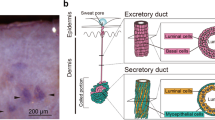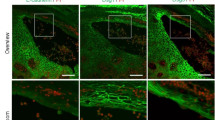Abstract
THE human eccrine gland is described in textbooks as being made up of a single convoluted secretory tubule continuous with an excretory duct opening to the skin surface at the sweat pore1. If this were universally true, the numbers of glands could always be equated with the numbers of pores, an inductive assumption made by many anthropologists when comparing the numbers of functional sweat glands in different races by means of pore counts, and also often assumed by physiologists concerned in sweat secretion2. In contrast, most embryologists expect to find some variation from the norm as a result of developmental anomalies, and in an average person having some three million terminal eccrine sweat ducts3 it would indeed be strange if a proportion of the eccrine glands in every individual did not show some anomalous development. The most frequent variant might be expected to be fortuitous bifurcation at the rapidly dividing apex of the gland primordium, which during embryonic life grows downward from the epidermis into the dermis as a cord of cells4. Such an anomaly would inevitably result in the formation of twin glands having a common terminal excretory duct. If this occurred, it would render enumeration of the numbers of glands by pore counts rather less reliable, depending on the proportion of variant glands present.
This is a preview of subscription content, access via your institution
Access options
Subscribe to this journal
Receive 51 print issues and online access
$199.00 per year
only $3.90 per issue
Buy this article
- Purchase on Springer Link
- Instant access to full article PDF
Prices may be subject to local taxes which are calculated during checkout
Similar content being viewed by others
References
Le Gros Clark, W. E., The Tissues of the Body (Clarendon Press, Oxford, 1965). Weiner, J. S., and Hellman, K., Biol. Rev., 35, 141 (1960).
Thomson, M. L., and Sutarman, Trans. Roy. Soc. Trop. Med. Hyg., 47, 412 (1953). Thomson, M. L., J. Physiol., 123, 225 (1954).
Szabó, G., in Advances in Biology of the Skin (edit. by Montagna, W., Ellis, R. A., and Silver, A. F.), 3, 1 (Pergamon Press, Oxford, 1962). Szabó, G., Phil. Trans. Roy. Soc., 252, 447 (1967).
Montgomery, H., Dermatopathology, 1 (Hoebner, New York, 1967).
Leach, E. H., Brit. J. Dermatol., 64, 183 (1952).
Hambrick, G. W., and Blank, H., J. Invest. Dermatol., 23, 437 (1954).
Author information
Authors and Affiliations
Rights and permissions
About this article
Cite this article
SPEARMAN, R. Branched Eccrine Sweat Glands in Normal Human Skin. Nature 219, 84–85 (1968). https://doi.org/10.1038/219084a0
Received:
Issue Date:
DOI: https://doi.org/10.1038/219084a0
Comments
By submitting a comment you agree to abide by our Terms and Community Guidelines. If you find something abusive or that does not comply with our terms or guidelines please flag it as inappropriate.



